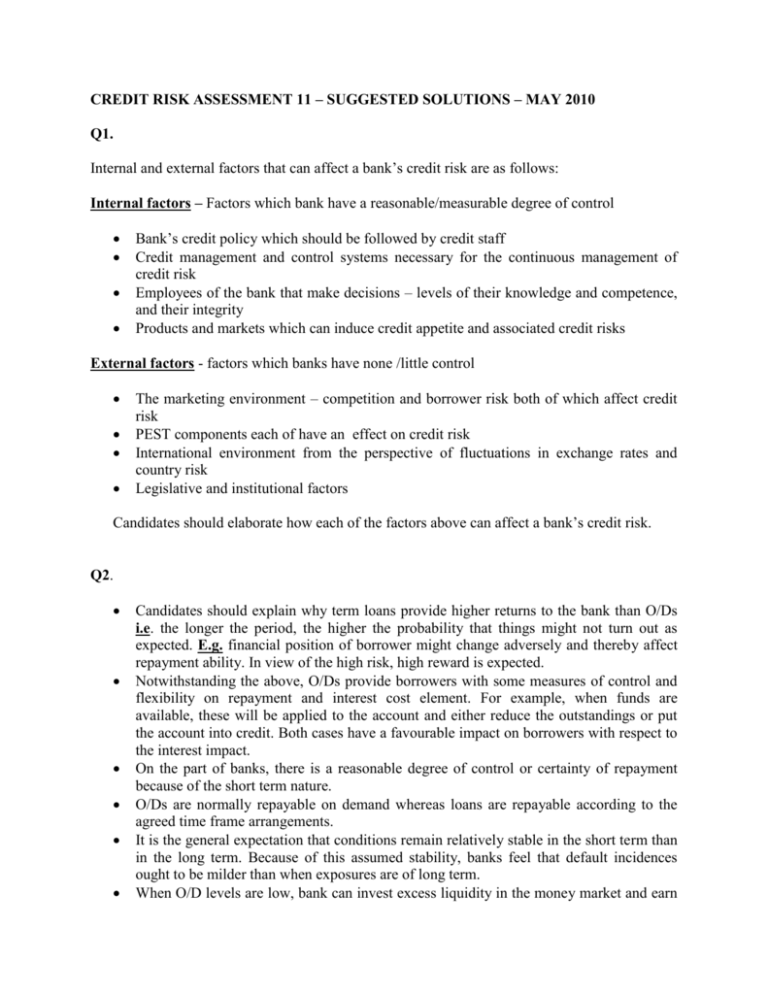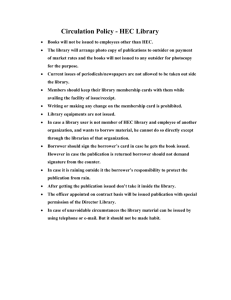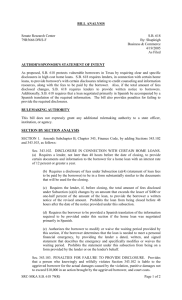credit risk assessment 11 – suggested solutions – may 2010
advertisement

CREDIT RISK ASSESSMENT 11 – SUGGESTED SOLUTIONS – MAY 2010 Q1. Internal and external factors that can affect a bank’s credit risk are as follows: Internal factors – Factors which bank have a reasonable/measurable degree of control Bank’s credit policy which should be followed by credit staff Credit management and control systems necessary for the continuous management of credit risk Employees of the bank that make decisions – levels of their knowledge and competence, and their integrity Products and markets which can induce credit appetite and associated credit risks External factors - factors which banks have none /little control The marketing environment – competition and borrower risk both of which affect credit risk PEST components each of have an effect on credit risk International environment from the perspective of fluctuations in exchange rates and country risk Legislative and institutional factors Candidates should elaborate how each of the factors above can affect a bank’s credit risk. Q2. Candidates should explain why term loans provide higher returns to the bank than O/Ds i.e. the longer the period, the higher the probability that things might not turn out as expected. E.g. financial position of borrower might change adversely and thereby affect repayment ability. In view of the high risk, high reward is expected. Notwithstanding the above, O/Ds provide borrowers with some measures of control and flexibility on repayment and interest cost element. For example, when funds are available, these will be applied to the account and either reduce the outstandings or put the account into credit. Both cases have a favourable impact on borrowers with respect to the interest impact. On the part of banks, there is a reasonable degree of control or certainty of repayment because of the short term nature. O/Ds are normally repayable on demand whereas loans are repayable according to the agreed time frame arrangements. It is the general expectation that conditions remain relatively stable in the short term than in the long term. Because of this assumed stability, banks feel that default incidences ought to be milder than when exposures are of long term. When O/D levels are low, bank can invest excess liquidity in the money market and earn a return. That said, however, loans are far more controllable than O/Ds. With O/Ds, it is not entirely unheard of instances of hardcore borrowings etc. diversion of funds are pretty common with O/Ds as compared to loans. As a control measure, with loans sometimes funds are paid direct to the intended beneficiaries i.e. parties to supply goods or services. With O/Ds, cheques can be issued and paid to anyone, including the drawer, whether or not payment is justified. Diversions/ conversions take place when cheques are made payable to cash for example and end up in the drawer’s pockets, totally outside the needs of the business. Of Q3. Importance of matching sources of finance with/to the nature of assets to be acquired From the lender’s viewpoint If long term obligations are used to fiancé short term assets Short term assets or working capital are of short term nature. Once depleted/exhausted, there would not be enough funds to serviced long term obligations. Debt may have to be called or rescheduled largely due to the mismatch. If short term obligations are use to finance long term assets Account management problems will result because there will be inadequate liquidity. Account likely to develop into hardcore or even fail to meet bank and outside obligations From the borrower’s viewpoint Maximization of owner’s wealth, in the case of equity finance Short term obligations normally fund working capital and thus provide liquidity Trade creditors provide working capital. The cash cycle is shortened and It is a cheap form of finance There is no interest involved If long term obligations are used to finance working capital, this will have an impact on profitability because of the burden of fixed interest cost Cash implications are encountered, either there is too much of it ( and hence unproductive but expensive), or too little of it and thus putting the business in a precarious position If long term assets are financed by short term funds, it will create a serious cash flow implication as total value of assets will have to be paid within 1yr whereas the productive life of the financed assets could span over several years It would also lead to serious illiquidity. Would force the business to sell assets at below value Illiquidity would mean inability to meet targeted sales volume, and therefore low profits Illiquidity could trigger cause for liquidation if business is unable to meet its obligations. Q4. Candidates should demonstrate their understanding of this cardinal rule and then explain reasons for departure. Reasons might include the following: It is far easier to absorb small unsecured exposures than large ones Very large exposures would normally be associated with acquisition of fixed assets, in which case, a charge over these assets is normally taken Bank’s position becomes precarious if a large single borrower defaults. This is mitigated by obtention of reliable security The security obtained demonstrates commitment on the part of the borrower to service the obligation for fear of losing asset(s) secured Large exposures are normally susceptible to fluctuation in trade conditions and banks would normally wish to obtain a cushion against these unfavourable events Notwithstanding the above explanations, candidates are expected to argue that, for example: Where appraisal / analysis is well structured, taking into account all risk factors, security NEED not be obtained even for the very large single exposures Very large single exposures, as the case is with multinational companies, usually have demonstrated competences to utilize funding effectively. Examples here could be , say, Illovo, Unilever, or Toyota, to mention a few names Very large single exposures are normally at the centre of the banks’ marketing engine rooms. Bank’s interest is to get that business, increase its lending book and beat the competitors. So competition for such very large single exposures can dispense of the need to extend secured advances. SECTION B Q5. Advantages Provides repayment cushion in the event that no other form of security is available Provides extra source of repayment in the sense that a lender might choose to ignore direct security tendered In the case of directors’’ guarantees, it ties-in directors to involve themselves with the activities of the company in order to ensure success and safeguard their guarantee exposure Guarantee can be relied upon in the event of a shortfall in the realization of direct security Formalities to take guarantee security relatively easy and without expenses Disadvantages Unless supported by tangible security, (resources/assets) it is as good as the worth of the guarantor. In other words, it may be a totally useless piece of paper in the security custody Realization can be contentious sometimes when guarantees are taken from spouses or persons who do not financial interest in the business Susceptible to misrepresentations and obtention of forged papers which would not legally admissible in the case of realization Sometimes people sign / execute guarantees simply for moral support and without the intention of ever being called upon to the obligation. In such cases, guarantees are totally capable of inflicting bad will and publicity against the bank May unintentionally deprive the guarantor of his /her assets in the event of realization whilst having been led to believe it was just a mere formality It is subject to the principle of borrower’s capacity i.e. whether of age, sanity etc May become unrealizable if taken from a subject in a country that is now enemy or wartorn, or where country risk is huge e.g. Zimbabwe in recent years Q6. Candidates need to demonstrate their understanding of these three principles of lending as being ones that provide prima facie comfort that the proposal is reasonably sound. Candidates also need to demonstrate their understanding of risk analysis methodology. In this respect, they are expected to state how, despite the proposal being reasonably sound, might be affected by the following risk factors; Business risk Industry risk Marker risk Financial risk Account risk Security risk Structural risk Management risk Candidates need to demonstrate that these eight risk parameters are in part externally influenced, and internally influenced. While the three principles provide common sense indicators, these risk parameters subject the proposal to severe stress test, to show where the real risk might lie even when the principles’ perspective, things might appear OK and acceptable. Q7 Candidates should demonstrate a coaching approach and explain that: In essence, the are no major differences except that with the PARTS and CAMPARI, a lender has a wider room to manouvre and is specifically guided by these lending pointers: PARTS - Purpose: what is the advance to be used for? What’s the purpose? - Amount: how much are being required to provide? Repayment ability: it is feasible, realistic and within the means of the borrower? Term of the loan/borrowing: is it reasonable and realistically within the - borrower’s resource generating capacity? Security: consideration/ appraisal of the security tendered - CAMPARI - Capital: does the borrower have enough of his own capital/ resources? The three C’s on the other hand, take a different angle altogether, aiming at the same target as follows: - Character - can the customer be relied upon to fulfill his obligations, all factors considered? - Capacity - does the borrower have the resource capacity to repay? - Amount: how much are we being requested and how does this relate to capital? Margin: what should our pricing be? Purpose: what’s the borrowing required for? Ability to repay the borrowing, given the purpose, amount and capital Repayment arrangements: are they feasible? Insurance: what security considerations do we have in mind? Capital - what is the worth of the borrower bearing in mind the amount under request? Ideally the three C’s provide a succinct appraisal of the proposal whereas the PARTS and CAMPARI approaches appear to broaden the credit enquiry. For the beginner, the latter two provide the basis for an objective appraisal and are to be encouraged. As one gains experience, the other perspectives as provided by the three C’s should be incorporated in the proposal assessment. The above are obviously attempts to answer the question posed. In the real credit world, we know that all the three stated approached are merely BASIC approaches to lending. Every proposal should also be thoroughly subjected to stress tests and ‘what if ‘analyses in a process described as credit risk analysis. This puts into the scenario many variables against which risk weights are allocated and ultimately influence the decision to lend or no to lend. Q8. Candidates would be awarded an extra mark if they state that every credit proposal carries with it certain elements of risk. The risk elements are as follows: Business Risk: this is the risk that






